In the dynamic world of content creation, finding captivating images that don’t infringe on copyright is an essential skill for bloggers. As we move into 2025, visual content has become even more critical in grabbing audience attention, enhancing SEO, and boosting engagement. Whether you’re a seasoned blogger or just starting out, learning the best ways to find royalty-free images can elevate your blog and protect you from legal troubles.
What Does Royalty-Free Really Mean?
The term royalty-free is often misunderstood. It doesn’t necessarily mean the image is free of cost; rather, it implies that once you’ve paid for the image—or acquired it from a free platform—you don’t need to pay royalties or licensing fees each time you use it. Understanding this distinction is crucial when sourcing images for blog posts.
Why Use Royalty-Free Images?
There are compelling reasons to stick to royalty-free images:
- Legal safety: Avoid potential fines or takedown notices.
- Consistency: High-resolution images can maintain a consistent aesthetic.
- Faster Workflow: Many royalty-free sites make it easy to quickly locate and download images.
Top Sources of Royalty-Free Images in 2025
The landscape of image sourcing has evolved, and several platforms stand out for their quality, ease of use, and generous licensing terms.
1. Unsplash
Still one of the most popular platforms in 2025, Unsplash offers a vast collection of high-resolution images submitted by creative photographers from around the world. All images are free to use for personal and commercial purposes without attribution—though crediting artists is always appreciated.
2. Pexels
Pexels provides an extensive library of free stock photos and videos. It has an intuitive search function and no-cost downloads, making it a favorite among bloggers. In recent updates, Pexels has introduced AI-powered recommendations, helping users find perfect visuals faster.

3. Pixabay
Pixabay remains a solid choice for not just photos, but also vector graphics, illustrations, and even music. As of 2025, their AI search suggestions significantly reduce time spent sifting through results.
4. Canva
Though primarily a design tool, Canva provides access to a huge collection of free and premium stock images for blogging, social media, and more. If you already use Canva for designs, it’s a convenient one-stop solution.
5. Burst by Shopify
Focused on eCommerce-friendly visuals, Burst offers free images curated specifically for business blogs, product promotions, and startup storytelling. The platform continues to expand its themes in 2025.
6. Generated Photos and AI Stock
The emerging category of AI-generated images is reshaping how bloggers access visuals. Sites like Generated Photos and AI Stock offer unique, royalty-free images created entirely by artificial intelligence. These eliminate privacy concerns or model release issues, which can be a problem with traditional photos.
New Tools and Techniques in 2025 for Finding Images
Technology now plays a massive role in helping bloggers find the right image in a fraction of the time. Here are a few of the latest innovations aiding this task:
1. AI-Powered Search Engines
Modern stock photo platforms like Unsplash and Pexels now use AI to analyze your content’s topic and suggest images that complement it perfectly. Grammarly-style plugins even integrate image search into content editors for real-time recommendations.
2. Image Curation Bots
These bots monitor your content schedule and suggest images based on trends and engagement analytics. Some even schedule future image swaps to keep content visually up-to-date.
3. Semantic Search
This advanced image retrieval method allows you to use natural language queries like, “a sunrise over a mountain in winter,” instead of exact keywords. Powered by NLP algorithms, these yield more accurate and contextually rich results.

Understanding Image Licenses
Even when using royalty-free platforms, it’s smart to check the licenses associated with images. Popular licenses include:
- Creative Commons Zero (CC0): Totally free for use without attribution.
- Creative Commons with Attribution (CC-BY): Requires user credit to the creator.
- Editorial Use Only: Can’t be used for commercial purposes. Keep this in mind to avoid legal missteps.
Tips for Using Images Ethically and Effectively
Once you’ve secured the perfect image, ensure its integration promotes your blog’s impact while respecting ethical norms.
- Credit the creator: Even when not mandatory, it builds goodwill and acknowledges talent.
- Customize images: Using tools like Canva or Figma, add text overlays or filters to tailor the image to your brand voice.
- Optimize for SEO: Name image files descriptively, use alt text, and keep image sizes optimized for faster loading times.
Avoiding Common Pitfalls
Here are a few common mistakes to steer clear of when sourcing royalty-free images:
- Overusing stock photos: Doing so can make your blog appear generic. Mix in your own visuals when feasible.
- Using images without checking licenses: Even on royalty-free platforms, some images may have usage restrictions.
- Ignoring branding: Choose imagery that aligns with your blog’s visual and emotional tone.
Future Trends in Royalty-Free Imagery
Looking ahead, we can expect several shifts in how bloggers find and use stock photography:
- AI-generated visuals: As realism in AI art increases, more bloggers will turn to automatically-generated content for unique imagery.
- Personalized image curation: Platforms will start offering feed-style dashboards based on user preferences, blog category, and traffic data.
- Voice search and visual discovery: Imagine asking your digital assistant, “Find me a cheerful image for a self-care blog post,” and instantly getting curated results. Voice search integration is not far off.
Conclusion
In 2025, the visual landscape of blogging is richer and more accessible than ever before. With advanced tools, AI-driven curation, and an expansive array of royalty-free sources, the task of enhancing your content visually is both easier and more exciting. Remember, images aren’t just decorative—they’re powerful tools of storytelling and engagement. By sourcing and using them smartly, ethically, and creatively, your blog can truly shine in the crowded digital space.
So whether you’re crafting your next listicle, travel diary, or product review, take the time to find the right visual companions. Your readers—and search engines—will thank you for it.
